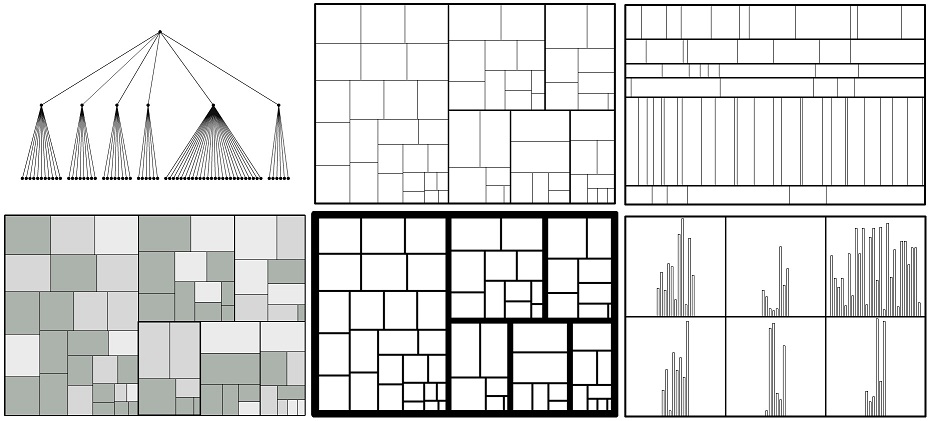Teaching:TUW - UE InfoVis WS 2010/11 - Gruppe 03 - Aufgabe 2: Difference between revisions
(introduction) |
(luminance and true percentage added) |
||
| Line 1: | Line 1: | ||
__TOC__ | |||
==Perceptual Guidelines for Creating Rectangular Treemaps== | ==Perceptual Guidelines for Creating Rectangular Treemaps== | ||
===Abstract=== | ===Abstract=== | ||
The following Article is a summaray of the work of Nicholas Kong, Jeffrey Heer, and Maneesh Agrawala [Nicholas Kont et al., 2010]. | The following Article is a summaray of the work of Nicholas Kong, Jeffrey Heer, and Maneesh Agrawala [Nicholas Kont et al., 2010]. | ||
| Line 12: | Line 12: | ||
* thickness of borders (used to encode hierarchy) | * thickness of borders (used to encode hierarchy) | ||
The problem with using treemaps is the use of area for encoding data. Studies have shown that people generally underestimate area, which leads to more inaccurate decoding than with other visualization types, like bar charts. Bar charts, on the other hand, are less space-efficient, not useful for visualization of hierarchies with more than two levels, and more difficult to read at higher data densities. The underlying work gives a guidline, when to use | The problem with using treemaps is the use of area for encoding data. Studies have shown that people generally underestimate area, which leads to more inaccurate decoding than with other visualization types, like bar charts. Bar charts, on the other hand, are less space-efficient, not useful for visualization of hierarchies with more than two levels, and more difficult to read at higher data densities. The underlying work gives a design guidline, based on three experiments, when to use treemaps and when to use other visual encodings and how to choose the parameters. | ||
===Pilot Study – True Percentage and Luminance=== | |||
The autors first conducted a pilot study on ‘’true percentage’’ and luminance to proof prior studies. | |||
The term ‘’true percentage’’ means the physical difference of two values measured in percent. | |||
Following results could be gained: | |||
*’’’true percentage has a strong effect on judgment accuracy’’’ | |||
More accurate judgment at either small (5%) or high (95%) percentage, more accurate judgment at multiples of 5 (due to our behavior to specify numbers at factors of 5) | |||
*’’’luminance has no significant effects on judgment accuracy’’’ | |||
Because area and luminance are separable perceptual dimensions, luminance does not interfere with area judgment. | |||
===References=== | |||
[Nicholas Kont et al., 2010] | |||
Nicholas Kong, Jeffrey Heer, Maneesh Agrawala. Perceptual Guidelines for Creating Rectangular Treemaps. ''IEEE Transactions on Visualization and computer Graphics'', 16(6):990-998, November/December 2010. | |||
Revision as of 20:28, 15 November 2010
Perceptual Guidelines for Creating Rectangular Treemaps
Abstract
The following Article is a summaray of the work of Nicholas Kong, Jeffrey Heer, and Maneesh Agrawala [Nicholas Kont et al., 2010]. It discusses the advantages and disadvantages of treemaps as visualization tool.
Treemaps - Basics

Treemaps are used for space efficient visualizing large, hierarchical datasets. Therefore every node in a tree is represented by a rectangular area in the treemap, where the size is proportional to the value of the node. The hierarchy of the tree is encoded by recursively subdividing the parent areas in the treemap. Following parameters have to be configured carefully to design perceptually effective treemaps:
- aspect ratio of rectangles (affected by the chosen layout algorithm)
- luminance of rectangles (used to encode additional variables)
- thickness of borders (used to encode hierarchy)
The problem with using treemaps is the use of area for encoding data. Studies have shown that people generally underestimate area, which leads to more inaccurate decoding than with other visualization types, like bar charts. Bar charts, on the other hand, are less space-efficient, not useful for visualization of hierarchies with more than two levels, and more difficult to read at higher data densities. The underlying work gives a design guidline, based on three experiments, when to use treemaps and when to use other visual encodings and how to choose the parameters.
Pilot Study – True Percentage and Luminance
The autors first conducted a pilot study on ‘’true percentage’’ and luminance to proof prior studies. The term ‘’true percentage’’ means the physical difference of two values measured in percent. Following results could be gained:
- ’’’true percentage has a strong effect on judgment accuracy’’’
More accurate judgment at either small (5%) or high (95%) percentage, more accurate judgment at multiples of 5 (due to our behavior to specify numbers at factors of 5)
- ’’’luminance has no significant effects on judgment accuracy’’’
Because area and luminance are separable perceptual dimensions, luminance does not interfere with area judgment.
References
[Nicholas Kont et al., 2010] Nicholas Kong, Jeffrey Heer, Maneesh Agrawala. Perceptual Guidelines for Creating Rectangular Treemaps. IEEE Transactions on Visualization and computer Graphics, 16(6):990-998, November/December 2010.